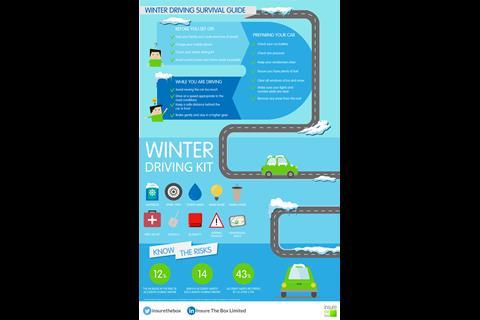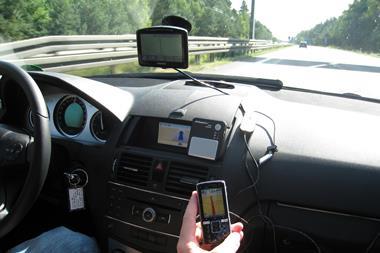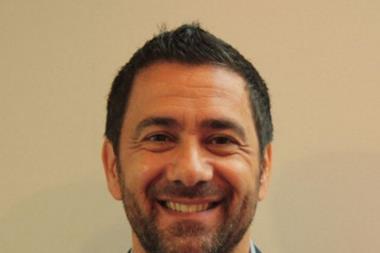Insure the box’s Head of Pricing, Sarah Vaughan speaks to Insurance Times Lead Researcher Savan Shah on how telematics data is transforming the car insurance industry, the insure the box winter driving survival guide and the fight to combat fraud through data.

It is reported that Insure the box holds 3.5bn miles of driving data, what key insights have you gained?
”We hold over 3.5 billion miles of driving data across insurethebox, Drive Like A Girl and Tesco Bank Box Insurance and associated claims. Our black boxes have enabled us to draw a number of important insights about driver behaviour”
- Males speed twice as frequently as females
- 18/19-year olds are the most reckless drivers
- One in 5 drivers still use their mobile phones, despite new laws banning them.
- Drivers who speed over 20% of the time increase their risk of having an accident by 87%.
- Following the Autumn clock change, accidents in November increase 29% between 5pm and 8pm compared to October. Overall, drivers face a 12% increase in accident risk in the month after Autumn clock change.
- 44% of Accident Alerts recorded by insurethebox occur after 5 o’clock in the evening.
How do you use this data?
”To reduce car insurance premiums for our customers: insurethebox uses telematics data to calculate premiums based on the driving behaviour of each individual driver. This enables us to tailor insurance for each of our customers – which saves them on average 37% on their first renewal. This is especially significant for younger drivers faced with prohibitively expensive car insurance.”
- ”To encourage safer driving and increase road safety: We can identify customers who are at greater risk of accidents based on their driving behaviour, proactively communicate with them to highlight the risks they pose and provide tips and tools to help them better manage their driving. Through one of our initiatives with habitual speeders – who are at very high risk of catastrophic injury – we reduced speeding instances by 15%. The biggest reduction in speeding is seen in 17-year olds who, on average, reduce their speeding frequency by 20% – our work has cut the frequency of accidents amongst these customers by 5%. This could translate into 50 lives saved every year and 800 fewer injuries on our roads if all insurers could do this. This initiative gained us recognition in the industry when we won an Insurance Times Tech and Innovations Award in 2017. We have also used data trends such as the increase in accidents when the clocks fall back to advise customers and increase road safety.”
”To help save lives if the worst happens: Our telematics boxes are fitted to each policyholder’s car and send an alert to insurethebox when a significant impact is detected. This enables us to contact the driver as well as alert emergency services where necessary. On average in 2017, insurethebox contacted the emergency services directly 10 times a month in response to an Accident Alert. To date, our Accident Alert service has registered nearly 100,000 alerts.”
- ”To combat fraud: our black boxes provide the DNA of a car accident, which enables us to detect and protect against fraudulent ‘crash for cash’ schemes, or instances where others make fraudulent claims against our customers.”
- ”To speed up the claims process: With our telematics insights we are able to settle claims more efficiently, which means we can get customers back on the road as quickly as possible.”
- “We proactively communicate with our customers, provide them each with their own personalised portal where they can manage their driving, and provide them with tips on how they could better manage their driving. The customer portal provides insight to empower customers to monitor and manage their driving behaviour.”

How are you reacting to the challenges GDPR will give you?
”We are embracing this change: our business relies on data – data quality and data accuracy - and we support any legislation that helps to protect our customers and allay public concerns over data misuse.”
Fraud detection & prevention – valued at £2bn a year – how is insurethebox reducing this impact?
“Telematics data is immensely powerful in identifying potentially fraudulent claims and our team comprises a unique mix of experts who have won a number of ground-breaking counter-fraud rulings in Court. We have developed a bespoke system for identifying fraud cases. In total we have thwarted claims for well over £500,000.”
Is there an example you can discuss that assisted insurers disprove questionable claims? Is there an example where a customer has used the data to disprove an insurer when a claim is in the first instance rejected?
£315,000 in fraudulent claims
”Telematics data helped protect a policyholder and disprove a version of events around an accident which was claimed by three members of the same family and a number of their associates with a history of prior personal injury motor claims. Telematics data proved that the accident took place on a different road to the one provided in the claim and showed that no genuine attempt was made by the driver to avoid the other vehicle, and that there was no significant attempt to slow the vehicle. The group was forced to discontinue their claim and ordered to pay costs of £60,000.”
£170,000 in fraudulent claims
”In one recent case we helped thwart over £170,000 in fraudulent claims. Five individuals submitted claims to insurethebox following an accident involving a BMW 3 series (driven by an insurethebox policyholder) and a Mercedes ML. In the accident the Mercedes suddenly slowed down, allegedly caused by a vehicle in front abruptly braking, and was hit by a BMW driving behind it. The BMW driver subsequently presented a claim for the loss of his vehicle, personal injury, and a variety of other alleged losses, and his passengers submitted claims for injuries they allegedly sustained. However, the various versions of events were inconsistent, and telematics data showed the presence of two accident alerts within a 7 second period, which the claimants failed to mention. Additionally they were unable to explain other events that the telematics data showed: the BMW driver drove past the Mercedes driver’s yard (where his business was based) 11 minutes before the alleged accident occurred, since the Mercedes driver claimed he did not leave the yard until four minutes before the alleged accident, causing the judge to question how the Mercedes ended up in front of the BMW.”
£22,250 in fraudulent claims
”A third party claimed that the fault lay with the insurethebox customer, alleging that a collision occurred when the insurethebox policyholder emerged at speed from a narrow side road, and with a burst tyre, at approximately 10.45pm. While the policyholder admitted the fact of a collision, he alleged it occurred in a different place, at an earlier time and as a result of the third party encroaching into his lane. Detailed analysis of the black box data presented in Court by a data expert from insurethebox was consistent with the customer’s witness statement. As a result, the judge dismissed the third party’s version of events as implausible, inconsistent and dangerous and stated that the telematics evidence was “overwhelming”.
In the eyes of drivers, the aim of having a black box is to ultimately reduce their car insurance premiums, since fruition what percentages of drivers have seen a reduction in premiums?
”A typical insurethebox box customer saves £650 across their first two years of motoring alone. Telematics enables access to insurance and driving for the highest risk group which pay the highest premiums. The average customer saving is up to 37% on renewal. Telematics insurance rates drivers for their individual risk based on their actual real life driving behaviour – not predictions of risk. While our average renewal saving is 37%, for some customers their renewal can see them save over £650.”
The data is also used to decide renewal premiums, with generous reductions for the best motorists – is there evidence of this occurring for the ‘best drivers’?
”The average saving is up to 37% on renewal but the better you drive, the more you save. Our best premiums go to those who stick well within the speed limit and drive within their mileage allowance.”
How do you determine the best variables to analyse a renewal quote?
”We determine premiums based on the following key risk factors for our customers”
- The time of day or night they drive
- The speed they drive at on different sorts of road
- If they brake or accelerate sharply
- If they take breaks on long journeys
- Their total mileage
- How many miles they drive on motorways
Which types of data do you envisage collecting in the future – to further enhance the assessment of drivers.
”Our understanding of the driving habits grows constantly – each day around 2 million miles are added to our knowledge base and we are continually investing in our analytical capabilities to ensure we get the best out of this data, both in terms of increased savings for our customers and reduced road accidents.”
How do you alleviate the concern some potential customers have regarding the safety and scope of the data you acquire?
”Unlike traditional insurance which imposes a rate calculated by broad demographics, meaning that safer drivers end up paying higher premiums to subsidise riskier drivers, insurethebox uses the customer data to give each customer a tailored/customised rate calculated by their own individual driving habits – as well as the tools to manage and improve their driving, putting the power to manage their premiums in their own hands. Customers that use insurethebox are able to access cost-effective insurance tailored to them and based on their own personal driving habits.”
”All of the information is fed directly back to our customers through our customer portal and used to calculate their premium – so data is used to their benefit and they get tailored pricing and support to manage their driving, increase road safety, and access mobility. Theft tracking, fighting bogus claims and our unique Accident Alert service all add to the benefits customers see in having a black-box policy. We hold this data with an utmost regard for security, don’t share it with anyone else and employ rigorous testing programmes before engaging with any hardware provider.”
Brokers are increasingly becoming more innovative in terms of the products and services they offer to gain a competitive edge – why should they be offering or asking their insurer partner to include telematics in motor cover?
”Telematics offers premiums to customers that are based on their actual driving behaviour rather than predicted behaviour – which means bespoke pricing at a time when motor insurance premiums are at record levels.
Ultimately connected cars will make telematics insurance ubiquitous but, for now, aftermarket devices are moving faster in terms of technology.
Insurance providers need to be looking at how these devices are evolving and the insights they can provide to remain relevant in the rapidly changing motor insurance market.”
Technology - key technologies have already begun to disrupt industries—with innovations in infrastructure and productivity, online sales applications, advanced analytics, machine learning, automation, robotics and virtual reality. How do you see the Insurance industry transforming in the years ahead?
- ”It will transform beyond recognition. From a motor insurance perspective, we will see closer alignment with motor manufacturers (OEMs)
- In motor insurance, we expect: cheaper premiums, safer driving, and increased mobility.
- We have calculated that proactive contact on safer driving with the highest risk motorists in the UK could mean 50 lives might be saved; there might be 800 fewer serious injuries and insurance costs may fall by 6%.
- Telematics is the future for car insurance – the technology will cut insurance costs significantly and open up the proposition to a wider market, as well as making roads safer.
- We have already seen exponential growth across the market according to BIBA’s research– this type of insurance is fast becoming mainstream. (Nearly 1 million live policies at January 2018)”
Hosted by comedian and actor Tom Allen, 34 Gold, 23 Silver and 22 Bronze awards were handed out across an amazing 34 categories recognising brilliance and innovation right across the breadth of UK general insurance.
















































No comments yet